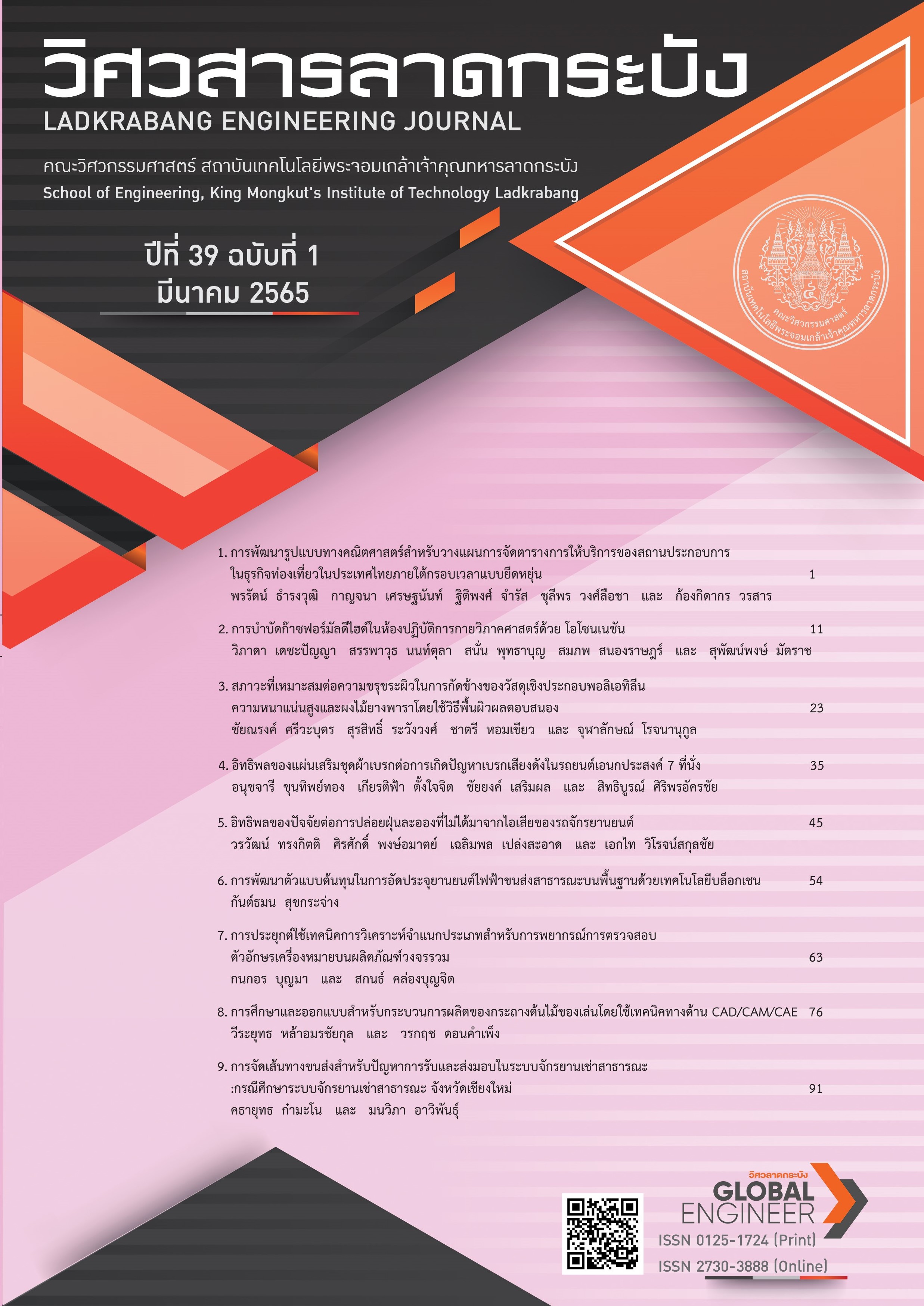The Application of Employing the Discriminant Analysis Technique to Forecast the Inspection Marking on the Integrated Circuit Product
Keywords:
Integrated Circuit (IC), Image Processing, Discriminant AnalysisAbstract
This research aims to study the process of inspecting product quality on Integrated Circuit and Packaging of Electronics factory. Since the size of integrated circuit is quite small with high quantity production, this makes it easy to have some mistakes during inspection process and launch low quality product to customers. According to these reasons, the researcher decided to develop the accurate and reliable inspection process to improve the efficiency of Vision Inspection and Packing Machine to minimize the reject rate of the mistaken inspection of Integrated circuit markings. The method of Linear Discriminant Analysis is applied to analyze the mistakes in inspection. At this Inspection and Packing Machine with image process, it is found that three light sources of this machine are the main potential predictor variables with 1) : Coaxial Ring Light, 2) : High Ring Light, and 3) : Low Ring Light and the one response variable of is the marking quality of integrated circuits in gray scale. Finally, the discriminant analysis equation is calculated to forecast the marking quality integrated circuits in Gray Scale. After this equation is applied, the calculation result shows that this equation yields the high efficiency of 92.6% after the actual implementation by setting the appropriate level of three potential predictor variables on Vision Inspection and Packing Machine: Coaxial Ring Light at 22, High Ring Light at 20 and Low Ring Light at 20 respectively with accuracy level of 96.7%, product quality yield increasing at level of 99.6% and the under reject products reducing at level of 0.6%.
References
“Electrical and Electronics Institute, “Integrated circuits, May. 31, 2020. Accessed: Apr. 28, 2021 [Online]. Available: http://eiu.thaieei.com/box/Products/9/IC%2031-05-2560.pdf
P. Pholphirul, “Roles of Thai Small and Medium Enterprises Under Creative Economy,” NIDA Economic Review Journal , vol. 7, no. 1, pp. 207–249, 2013.
C. Laofor and V. Peansupa, “Defect Detection and Quantification System to Support Subjective Visual Quality Inspection Via a Digital Image Processing: A Tiling Work Case Study,” Automation in Construction, vol. 24, pp. 160–174, 2012, doi:10.1016/j.autcon.2012.02.012.
J. Hesselbach, H. W. Hoffmeister and T. Loohß, “Process-Integrated Quality Assurance in Wood Machining Centers with The Help of Image Processing,” Production Engineering, vol. 1, no. 1, pp. 97–101, 2007, doi:10.1007/s11740-007-0032x.
Q. Luo and Y. Heb, “A Cost-Effective and Automatic Surface Defect Inspection System for Hot-Rolled Flat Steel,” Robotics and Computer-Integrated Manufacturing, vol. 38, no. 1, pp. 16–30, 2016, doi: .org/10.1016/j.rcim.2015.09.008.
S. Xianjiang, Z. Yue, S. Peng, S. Han, L. Xiaohui and W. Andong, “Automotive Airbag Assembly Quality Visual Inspection Method Studies Based on MATLAB,” in Proc. 2012 2nd International Conference on Computer Science and Network Technology, Changchun, China, Dec. 29-31, 2012, pp. 1225–1228, doi: 10.1109/ICCSNT.2012.6526145.
W. Boonsuk, “Applying for Classifying System of Rubber Quality Using Technique of Color Average,” The Journal of KMUTNB, vol. 25, no. 2, 2015.
A. Pannawan and S. Sudsawat, “Automated part inspection by image processing system in vehicle part manufacturing,” The Journal of Applied Science, vol. 16, no. 1, pp. 45–59, 2017, doi: 10.14416/j.appsci.2017.06.001.
J. Varagul, “Development of Automatic Visual Inspection Machine for HDD Manufacturing Process,” M.S. Thesis, Dept. Mechanical Engineering, Suranaree University of Technology, Nakhon Ratchasima, Thailand, 2010.
V. Saeheir, “Forecasting of Steel Plate in Hot-Dip Galvanized Process by Discriminant Analysis: A Case Study of Hot-Dip Galvanized Factory,” M.S. Thesis, Dept. Industrial Engineering, King Mongkut’s Institute of Technology Ladkrabang, Bangkok, Thailand, 2019.
A. A. D’Archivio and M. A. Maggi, “Geographical Identification of Saffron (Crocus Sativus L.) by Linear Discriminant Analysis Applied to The UV-Visible Spectra of Aqueous Extracts,” Food Chemistry, vol. 219, pp. 408–413, 2017, doi: org/10.1016/j.foodchem.2016.09.169.
M. Toğaçar, B. Ergen and Z. Cömert, “Application of Breast Cancer Diagnosis Based on a Combination of Convolutional Neural Networks, Ridge Regression and Linear Discriminant Analysis Using Invasive Breast Cancer Images Processed with Autoencoders,” Medical Hypotheses, vol. 135, 2020, doi: org/10.1016/j.mehy.2019.109503
Z. Jing, G. Wang, S. Zhang and C. Qiu, “Building Tianjin Driving Cycle Based on Linear Discriminant Analysis,” Transportation Research Part D: Transport and Environment, vol. 53, pp.78–87, 2017, doi: org/10.1016/j.trd.2017.04.005
K. Wanichbuncha, “Discriminant Analysis,” in Multivariate analysis, Bangkok, Thailand: Chulalongkorn University Press, 2008, ch. 10, sec. 10.1–10.11, pp. 375–405.
J. F. Hair, W. C. Black, B. J. Babin and R. E. Anderson, “Multiple Discriminant Analysis,” in Multivariate data analysis: A Global Perspective, 7th ed. NJ, USA: Pearson Prentice Hall,2010, ch. 7, sec. 4, pp. 471–547.
Downloads
Published
How to Cite
Issue
Section
License
Copyright (c) 2022 Faculty of Engineering, King Mongkut’s Institute of Technology Ladkrabang

This work is licensed under a Creative Commons Attribution-NonCommercial-NoDerivatives 4.0 International License.
The published articles are copyrighted by the School of Engineering, King Mongkut's Institute of Technology Ladkrabang.
The statements contained in each article in this academic journal are the personal opinions of each author and are not related to King Mongkut's Institute of Technology Ladkrabang and other faculty members in the institute.
Responsibility for all elements of each article belongs to each author; If there are any mistakes, each author is solely responsible for his own articles.






